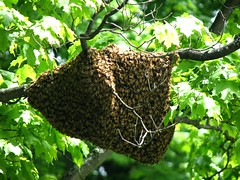 (Herr Dr. von Frisch looks great in lederhosen, don't you think?).
(Herr Dr. von Frisch looks great in lederhosen, don't you think?). Karl von Frisch discovered that European honeybees (Apis mellifera) could communicate the precise location of a resource by dancing.
(Can you imagine anything more wonderful? What if we communicated through dance alone? Tell me that doesn't sound like fun.)
The dance has two components: an angle and a distance - all the bees need to find a location. The angle is communicated by the angle at which the bee takes a waggle run relative to straight up. Outside, this angle corresponds to the angle of the resource relative to the sun. The length of time the dancing bee spends waggling corresponds to the distance to the food resource. When a forager bee comes back from collecting food, she will dance, and in the dark hive, other bees will surround her and follow her dancing movements repeatedly, extracting the location information from her movements. Then the foragers will set out to the location she indicated. This is the basic formula for the dance language. Other aspects, such as sharing nectar samples, floral odors, and vibrational signals also play a role in telling the other bees the type and quality of the food resource.
The dance language is also used when a swarm (a newly budded bee community ready to start their own hive) needs to find a hollow cavity to nest in. Scouts that find a suitable cavity dance to communicate its location to the other workers. The better the cavity, the longer a bee will dance for it. This length of time spent dancing is key to the collective decision-making of the swarm, which must take off all at once and move together if they are to survive. The longer a bee dances for a location, the more recruits she will get to check out the possible new home, and the more bees will come back to dance for that location. Eventually, almost all the scouts will be dancing for the preferred location. Once they have reached a quorum, the bees take off to colonize the new home.
So that's the fantastic story of the honeybee dance language. My question is: why so sophisticated? Why do honeybees alone among invertebrates demonstrate use of symbols? Why are honeybees considered the pinnacle of insect communication? Honeybees themselves are not very remarkable insects. Physiologically, they are similar to their bumblebee and wasp brethren in brain capacity. One thing that they do have that many other bees and wasps lack, however, is eusociality.
Eusociality is the term we use to describe social animals where there is:
- Reproductive division of labor - some individuals reproduce while others give up or delay their own reproduction
- Overlapping generations - individuals from previous generations live together with individuals from the current generation
- Cooperative care of young - non-reproductive individuals rear other individuals' offspring
 Only a handful of animal species fit this definition. In many ways, honeybees wrote this definition. A single queen bee lays all the eggs in the hive, while the workers (sisters and offspring of the same queen) do all the work of gathering food, feeding the young, constructing, maintaining, and guarding the nest. The honeybee hive functions as a super-organism, with each individual doing its part to serve the hive. The critical phase in the reproduction of this super-organism is the swarming stage, when the hive buds, and a group of bees and a queen must choose a new nest. For the European honeybee, which requires a suitable cavity, this selection process is very important to deciding the future fate of the swarm. You could imagine that the selective pressure would be extremely high for an efficient way of communicating the location of a possible new nest site.
Only a handful of animal species fit this definition. In many ways, honeybees wrote this definition. A single queen bee lays all the eggs in the hive, while the workers (sisters and offspring of the same queen) do all the work of gathering food, feeding the young, constructing, maintaining, and guarding the nest. The honeybee hive functions as a super-organism, with each individual doing its part to serve the hive. The critical phase in the reproduction of this super-organism is the swarming stage, when the hive buds, and a group of bees and a queen must choose a new nest. For the European honeybee, which requires a suitable cavity, this selection process is very important to deciding the future fate of the swarm. You could imagine that the selective pressure would be extremely high for an efficient way of communicating the location of a possible new nest site.This is only one theory that might explain the evolution of such complex behavior in honeybees rather than other species which do not exhibit swarm-founding. Indeed, the selective pressure for more advanced communication must increase with increasing levels of cooperative behavior. Is this true? Do we find other examples in the animal kingdom of advanced communication in conjunction with cooperative behavior?

No comments:
Post a Comment